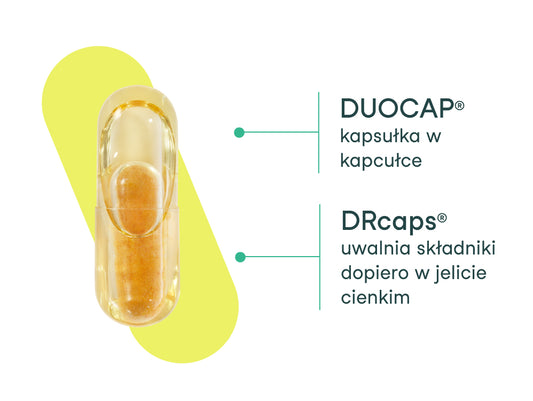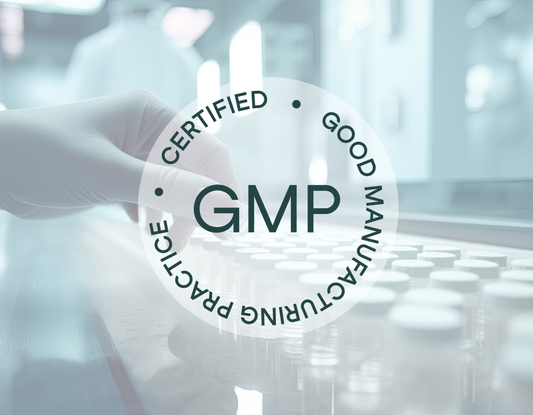
More than half of us may have problems with the absorption of folic acid. Instead of being absorbed, it can accumulate in the blood, impair brain functions and even accelerate the development of cancer. Folate is a safer choice than regular folic acid.
Many of us associate folic acid with products for pregnant women. However, supplementing with vitamin B9, one form of which is folic acid, can be beneficial for many people. At the same time, it can also be harmful if we choose the wrong supplement. Even brands considered premium contain ordinary, cheap folic acid, which is not absorbed. Accumulating in the blood, it can have a toxic effect on our body. But let's talk about everything in order.
Folic acid and folates – what is the difference?
Vitamin B9 is necessary for the proper functioning of every human body. It takes part in cell division and the formation of DNA structures. It occurs in nature and in our bodies in the form of folates . This is the collective name for various forms of this vitamin. In other words, folate is natural vitamin B9 . Folic acid, in turn, is its synthetic equivalent . Does that mean it's worse? It is an inactive form that the body must convert into folates to be able to use it. And this is the key issue. Not all of us are able to accomplish this transformation of folic acid.
Up to 60% of people may not absorb regular folic acid.
Synthetic folic acid enters our body from dietary supplements or food products enriched with it (e.g. breakfast cereals or bread). Then, 4 stages of transformation await him . Ultimately, the active compound 5-MTHF (methylfolate) should be created 1 , which the body can use for its needs. These transformations take place with the participation of enzymes, digestive organs, the liver and with the support of certain genes . However, scientists say that up to 60% of people may have a genetic mutation that makes the entire process impossible 2 . This is a mutation of the MTHFR gene, which is often associated with an increased risk of miscarriages in women, as well as hypertension, thrombosis, mental disorders and some types of cancer 3 . In all these health problems, the lack of folates available to the body plays an important role if we do not provide them in an appropriate, active form from the outside.
What happens to the folic acid that we have swallowed but cannot absorb?
Let's say we have this mutation or we can't convert regular folic acid into active folate for other reasons. What happens to it in our body? Accumulates in the blood . If a pregnant woman supplements regular folic acid and cannot metabolize it, its inactive form also passes to the baby through the placenta. 4 . By taking subsequent doses of regular folic acid or eating fortified foods, we accumulate more and more inactive vitamin B9 in the blood. 5.6 . This may have a toxic effect . If the level of folic acid in the blood is too high, it can lead to:
- slowed brain development in 4-5-year-old children 7 and a greater risk of insulin resistance 8 in children aged 9-13 if the mother supplemented too high doses of folic acid during pregnancy;
- increased development of cancer cells 9 , 10 and recurrence of certain types of cancer (e.g., colorectal 11 or prostate 12 );
- masking the symptoms of vitamin B12 deficiency and associated megaloblastic anemia 13 . This condition permanently damages nerve cells and brain function 14 ;
- brain function disorders in older people, especially if they also have low levels of vitamin B12 in the blood 15,16 .
An important moment. Even small doses of synthetic folic acid (e.g. daily "standard" 400 mcg) can accumulate in the blood and be dangerous to health if we are unable to metabolize them. 17 . Researchers found inactive folic acid in blood samples of virtually all U.S. children, teens and adults who took supplements (2007-2008 study) 18 .
What type of folate is best?
Since synthetic folic acid can harm many people, maybe it is worth just eating more products naturally containing folate ? Unfortunately, this solution also has its weak points . Yes, some vegetables, especially green and leafy ones, contain relatively much folate. However, supplementing them only through diet would mean that we have to eat at least 0.4 kg of broccoli or 0.8 kg of Brussels sprouts every day. 19 . If we haven't done this recently, we may be deficient and need even larger amounts of folate.
Another problem - scientists agree that folates from food are not well absorbed by the body 20 . To transform into an active form, they also have to go through several stages and need, among others: special enzymes secreted by intestinal cells 21 . Genetic mutations can disrupt this process, as with regular folic acid. It is estimated that our body is able to use only 50% of folates from food 22 .
What remains? Provide the body with the most active form from the outside that the body can use immediately. No transformation required.
Quatrefolic is the most bioavailable form of folate on the market.
Currently, active folic acid can be found on the dietary supplement market in the following forms:
- Calcium L-methylfolate (aka Metafolin or calcium salt (6s)-5-MTHF)
- Quatrefolic (also known as Folate IV generation or glucosamine salt of (6s)-5-MTHF acid).
What is the difference between these 2 forms? The first one is less bioavailable and stable only at temperatures of 2-8°C. It is also not very soluble in water. The second one, Quatrefolic, is more stable ( even at 25°C) and bioavailable . Preclinical studies showed that after supplementation, the concentration of Quatrefolic in the blood was 20% higher than that of calcium L-methylfolate. Quatrefolic is also 100 times more soluble in water than calcium salt (6s)-5-MTHF 23 .
The above facts prove that Quatrefolic is the best form of folic acid available on the market. The body can use fourth-generation folates immediately, regardless of gene mutations and other health problems. It is also the only form of folate that penetrates the blood-brain barrier 23 . Quatrefolic is an innovative and patented ingredient, and its safety has been confirmed in Europe (EFSA, European Commission Novel Food approval), USA (GRAS, FDA approval), Australia, South Korea and China 24 .
Why is it worth supplementing folate?
According to research, most adult Poles do not consume the recommended daily amount of folate 25 . In addition, long-term food storage and thermal processing may reduce their content in food. Additionally, their absorption from the diet may be impaired by digestive problems, alcohol consumption and cigarette smoking . The absorption of folates is also blocked by some medications , including: non-steroidal anti-inflammatory drugs (e.g. ibuprofen, aspirin), drugs that affect the acidity of the gastrointestinal tract or anti-tuberculosis drugs 26 . Therefore, dietary supplements can help replenish the necessary vitamin B9, which humans do not produce and cannot obtain in sufficient quantity even from a varied diet.
The benefits of folate supplementation can be experienced by people at various stages of life. Folates support the functioning of our immune system . Their deficiency may cause chronic inflammation , which leads to various diseases, including life-threatening ones 27,28,29 . Vitamin B9 also participates in blood production and protects heart health , supports the prevention of coronary heart disease, thrombosis, atherosclerosis, heart attack and stroke. 30,31,32,33 . Folate helps in states of constant fatigue 34 and support cognitive function (e.g. memory) 35,36 . They may also delay brain aging and lower the risk of dementia 37 . During pregnancy, folates reduce the risk of fetal developmental disorders and the resulting pregnancy complications and miscarriages by as much as 70%. 38,39,40 .
Bibliography:
- Myszczyszyn, Aneta & Krajewski, Rafał & Ostapów, Monika & Hirnle, Lidia. (2019). Folic acid – role in the body, recommendations and clinical significance. Nursing in the 21st century. 18. 10.2478/pielxxiw-2019-0007.
- Long S. Goldblatt J., “MTHFR genetic testing: Controversy and clinical implications.” Journal of The Royal Australian College of General Practitioners, April 2016.
- “MTHFR gene”, National Library of Medicine, National Institute of Health, medlineplus.gov, accessed March 8, 2022.
- Plumptre L, Masih SP, Ly A, Aufreiter S, Sohn KJ, Croxford R, Lausman AY, Berger H, O'Connor DL, Kim YI. High concentrations of folate and unmetabolized folic acid in a cohort of pregnant Canadian women and umbilical cord blood. Am J Clin Nutr. 2015 Oct;102(4):848-57.
- Boilson A, Staines A, Kelleher CC, Daly L, Shirley I, Shrivastava A, Bailey SW, Alverson PB, Ayling JE, McDermott AP, MacCooey A, Scott JM, Sweeney MR. Unmetabolized folic acid prevalence is widespread in the older Irish population despite the lack of a mandatory fortification program. Am J Clin Nutr. 2012 Sep;96(3):613-21.
- Obeid R, Kirsch SH, Dilmann S, Klein C, Eckert R, Geisel J, Herrmann W. Folic acid causes higher prevalence of detectable unmetabolized folic acid in serum than B-complex: a randomized trial. Eur J Nutr. 2016 Apr;55(3):1021-8.
- Valera-Gran D, Navarrete-Muñoz EM, Garcia de la Hera M, Fernández-Somoano A, Tardón A, Ibarluzea J, Balluerka N, Murcia M, González-Safont L, Romaguera D, Julvez J, Vioque J; INMA Project. Effect of maternal high doses of folic acid supplements on neurocognitive development in children at 4-5 y of age: the prospective birth cohort Infancia y Medio Ambiente (INMA) study. Am J Clin Nutr. 2017 Sep;106(3):878-887.
- Krishnaveni GV, Veena SR, Karat SC, Yajnik CS, Fall CH. Association between maternal folate concentrations during pregnancy and insulin resistance in Indian children. Diabetology. 2014 Jan;57(1):110-21.
- Kim YI. Folate and cancer: a tale of Dr. Jekyll and Mr. Hyde? Am J Clin Nutr. 2018 Feb 1;107(2):139-142.
- Patel KR, Sobczyńska-Malefora A. The adverse effects of an excessive folic acid intake. Eur J Clin Nutr. 2017 Feb;71(2):159-163.
- Cole BF, Baron JA, Sandler RS, Haile RW, Ahnen DJ, Bresalier RS, McKeown-Eyssen G, Summers RW, Rothstein RI, Burke CA, Snover DC, Church TR, Allen JI, Robertson DJ, Beck GJ, Bond JH, Byers T, Mandel JS, Mott LA, Pearson LH, Barry EL, Rees JR, Marcon N, Saibil F, Ueland PM, Greenberg ER; Polyp Prevention Study Group. Folic acid for the prevention of colorectal adenomas: a randomized clinical trial. CAVITY. 2007 Jun 6;297(21):2351-9.
- Figueiredo JC, Grau MV, Haile RW, Sandler RS, Summers RW, Bresalier RS, Burke CA, McKeown-Eyssen GE, Baron JA. Folic acid and risk of prostate cancer: results from a randomized clinical trial. J Natl Cancer Inst. 2009 Mar 18;101(6):432-5.
- Field MS, Stover PJ. Safety of folic acid. Ann NY Acad Sci. 2018;1414(1):59-71.
- “Vitamin B12. Fact Sheet for Health Professionals,” National Institutes of Health, Office of Dietary Supplements, ods.od.nih.gov, April 6, 2020.
- Bailey RL, Jun S, Murphy L, Green R, Gahche JJ, Dwyer JT, Potischman N, McCabe GP, Miller JW. High folic acid or folate combined with low vitamin B-12 status: potential but inconsistent association with cognitive function in a nationally representative cross-sectional sample of US older adults participating in the NHANES. Am J Clin Nutr. 2020 Dec 10;112(6):1547-1557.
- Moore EM, Ames D, Mander AG, Carne RP, Brodaty H, Woodward MC, Boundy K, Ellis KA, Bush AI, Faux NG, Martins RN, Masters CL, Rowe CC, Szoeke C, Watters DA. Among vitamin B12 deficient older people, high folate levels are associated with worse cognitive function: combined data from three cohorts. J Alzheimers Dis. 2014;39(3):661-8.
- Sweeney MR, McPartlin J, Scott J. Folic acid fortification and public health: report on threshold doses above which unmetabolized folic acid appear in serum. BMC Public Health. 2007 Mar 22;7:41.
- Pfeiffer CM, Sternberg MR, Fazili Z, Yetley EA, Lacher DA, Bailey RL, Johnson CL. Unmetabolized folic acid is detected in nearly all serum samples from US children, adolescents, and adults. J Nutr. 2015 Mar;145(3):520-31.
- Przygoda B., “Folate (folate, folic acid)”, Practical medicine for patients, mp.pl, May 29, 2012.
- Caudill M.A. Folate bioavailability: implications for establishing dietary recommendations and optimizing status. Am J Clin Nutr. 2010;91(5):1455S-1460S.
- Myszczyszyn A., op.cit.
- “Folate. Fact Sheet for Health Professionals.” National Institutes of Health, Office of Dietary Supplements, ods.od.nih.gov, March 29, 2021.
- “Quatrefolic vs. Folic Acid”, Gnosis by Lesaffre, quatrefolic.com, 2021.
- “Regulatory and Intellectual Property”, quatrefolic.com, accessed January 10, 2022.
- Sicińska E., Wyka J., "Folate intake in Poland based on the literature from the last 10 years (2000-2010)", Roczniki Polskiego Zakład Higieny, 2011.
- Mziray M., Siepsiak M., Żuralska R., Domagała P., “The importance of folic acid in the diet of older people. The validity of food supplementation. Polish Nursing, June 2017
- A Dhur, P Galan, S Hercberg. Prog Food Nutr Sci. 1991;15(1-2):43-60. Folate status and the immune system.
- Catherine J Field et al. J Nutr Biochem. 2006 Jan;17(1):37-44. Dietary folate improves age-related decreases in lymphocyte function.
- Kathleen Mikkelsen and Vasso Apostolopoulos. Victoria University Melbourne. In book: Nutrition and Immunity (pp.103-114). Vitamin B12, Folic Acid, and the Immune System. July 2019.
- Charalambos Antoniades et al. Circulation. 2006 Sep 12;114(11):1193-201. 5-methyltetrahydrofolate rapidly improves endothelial function and decreases superoxide production in human vessels: effects on vascular tetrahydrobiopterin availability and endothelial nitric oxide synthase coupling.
- Yuan Wang et al. Medicine (Baltimore). 2019 Sep; 98(37): e17095. Published online 2019 Sep 13. The effect of folic acid in patients with cardiovascular disease. A systematic review and meta-analysis.
- Tao Tian et al. Am J Med Sci. 2017 Oct;354(4):379-387. Folic Acid Supplementation for Stroke Prevention in Patients With Cardiovascular Disease.
- EFSA Journal 2010;8(10):1760. Scientific Opinion on the substance of health claims related to folate and contribution to normal psychological functions, maintenance of normal vision, reduction of tiredness and fatigue, cell division and contribution to normal amino acid synthesis.
- In Jacobson et al. Neurology. 1993 Dec;43(12):2645-7. Serum folate and chronic fatigue syndrome.
- Fei Ma et al.. Sci Rep. 2016; 6: 37486. Published online 2016 Nov 23. Folic acid supplementation improves cognitive function by reducing the levels of peripheral inflammatory cytokines in elderly Chinese subjects with MCI.
- E. H. Reynolds. BMJ. 2002 Jun 22; 324(7352): 1512–1515. doi: 10.1136/bmj.324.7352.1512. Folic acid, aging, depression, and dementia.
- EFSA Journal 2010, op.cit.
- LE Martínez-Garza. Editorial. October - December 2016. Twenty-five years of knowledge of the prevention of neural tube defects with folic acid.
- Yvonne Lamers et al.. Am J Clin Nutr. 2006 Jul;84(1):156-61. Red blood cell folate concentrations increase more after supplementation with [6S]-5-methyltetrahydrofolate than with folic acid in women of childbearing age.
- Seremak-Mrozikiewicz A et al. The significance of 1793G>A polymorphism in MTHFR gene in women with first trimester recurrent miscarriages. Neuro Endocrinol Lett. 2010.


What makes our capsule stand out?
The nikalab capsule impresses not only with its appearance, but also with its operation. We used two innovative...








